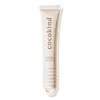What's inside
What's inside
 Key Ingredients
Key Ingredients

 Benefits
Benefits

 Concerns
Concerns

 Ingredients Side-by-side
Ingredients Side-by-side

Phytosteryl/Isostearyl/Cetyl/Stearyl/Behenyl Dimer Dilinoleate
Skin ConditioningDiisostearyl Malate
EmollientHydrogenated Polyisobutene
EmollientPolybutene
Hydrogenated Poly(C6-14 Olefin)
EmollientButyrospermum Parkii Butter
Skin ConditioningMicrocrystalline Wax
Emulsion StabilisingOctyldodecanol
EmollientSynthetic Wax
AbrasiveDisteardimonium Hectorite
StabilisingAstrocaryum Murumuru Seed Butter
EmollientSodium Hyaluronate
HumectantTocopherol
AntioxidantMentha Piperita Oil
MaskingMenthone Glycerin Acetal
RefreshingStevia Rebaudiana Extract
Vanillin
MaskingRicinus Communis Seed Oil
MaskingPropylene Carbonate
SolventPolyglyceryl-2 Diisostearate
EmulsifyingMica
Cosmetic ColorantBHT
AntioxidantLimonene
PerfumingLinalool
PerfumingPhytosteryl/Isostearyl/Cetyl/Stearyl/Behenyl Dimer Dilinoleate, Diisostearyl Malate, Hydrogenated Polyisobutene, Polybutene, Hydrogenated Poly(C6-14 Olefin), Butyrospermum Parkii Butter, Microcrystalline Wax, Octyldodecanol, Synthetic Wax, Disteardimonium Hectorite, Astrocaryum Murumuru Seed Butter, Sodium Hyaluronate, Tocopherol, Mentha Piperita Oil, Menthone Glycerin Acetal, Stevia Rebaudiana Extract, Vanillin, Ricinus Communis Seed Oil, Propylene Carbonate, Polyglyceryl-2 Diisostearate, Mica, BHT, Limonene, Linalool
Polybutene
Ethylhexyl Palmitate
EmollientCaprylic/Capric Triglyceride
MaskingHydrogenated Castor Oil
EmollientStearalkonium Hectorite
Gel FormingRicinus Communis Seed Oil
MaskingGlycerin
HumectantCeramide NP
Skin ConditioningCeramide AP
Skin ConditioningPortulaca Pilosa Extract
Skin ConditioningTocopherol
AntioxidantVaccinium Macrocarpon Seed Oil
Skin ConditioningHelianthus Annuus Seed Oil
EmollientPalmitoyl Tripeptide-38
Skin ConditioningCetearyl Ethylhexanoate
EmollientIsostearyl Isostearate
EmollientPolyglyceryl-3 Diisostearate
EmulsifyingPolyglyceryl-3 Polyricinoleate
EmulsifyingSorbitan Isostearate
EmulsifyingSucrose Cocoate
EmulsifyingTitanium Dioxide
Cosmetic ColorantPolybutene, Ethylhexyl Palmitate, Caprylic/Capric Triglyceride, Hydrogenated Castor Oil, Stearalkonium Hectorite, Ricinus Communis Seed Oil, Glycerin, Ceramide NP, Ceramide AP, Portulaca Pilosa Extract, Tocopherol, Vaccinium Macrocarpon Seed Oil, Helianthus Annuus Seed Oil, Palmitoyl Tripeptide-38, Cetearyl Ethylhexanoate, Isostearyl Isostearate, Polyglyceryl-3 Diisostearate, Polyglyceryl-3 Polyricinoleate, Sorbitan Isostearate, Sucrose Cocoate, Titanium Dioxide
 Reviews
Reviews

Ingredients Explained
These ingredients are found in both products.
Ingredients higher up in an ingredient list are typically present in a larger amount.
Polybutene is used to help control the viscosity of a product. This just means it helps adjusts the texture.
It is a polymer and does not get absorbed into the skin due to its large size.
Studies found this ingredient did not irritate skin in concentrations below 15%.
Learn more about PolybuteneRicinus Communis Seed Oil is the INCI name for castor oil.
Castor Oil helps moisturize the skin. It is rich in a fatty acid called ricinoleic acid. This fatty acid helps prevent moisture loss on the skin. This helps keep your skin soft and hydrated. Ricinoleic acid also has anti-inflammatory and pain reducing properties.
Besides hydrating the skin, castor oil is also used to hydrate hair. By keeping the hair shaft moisturized, breakage is decreased. More studies are needed to show castor oil's effective on stimulating hair growth.
Castor oil is created by cold-pressing castor seeds and then purifying the oil with heat. It was used in Ancient Egypt as fuel in lamps and to help treat eye irritation.
The term 'fragrance' is not regulated in many countries. In many cases, it is up to the brand to define this term. For instance, many brands choose to label themselves as "fragrance-free" because they are not using synthetic fragrances. However, their products may still contain ingredients such as essential oils that are considered a fragrance.
Learn more about Ricinus Communis Seed OilTocopherol (also known as Vitamin E) is a common antioxidant used to help protect the skin from free-radicals and strengthen the skin barrier. It's also fat soluble - this means our skin is great at absorbing it.
Vitamin E also helps keep your natural skin lipids healthy. Your lipid skin barrier naturally consists of lipids, ceramides, and fatty acids. Vitamin E offers extra protection for your skin’s lipid barrier, keeping your skin healthy and nourished.
Another benefit is a bit of UV protection. Vitamin E helps reduce the damage caused by UVB rays. (It should not replace your sunscreen). Combining it with Vitamin C can decrease sunburned cells and hyperpigmentation after UV exposure.
You might have noticed Vitamin E + C often paired together. This is because it is great at stabilizing Vitamin C. Using the two together helps increase the effectiveness of both ingredients.
There are often claims that Vitamin E can reduce/prevent scarring, but these claims haven't been confirmed by scientific research.
Learn more about Tocopherol